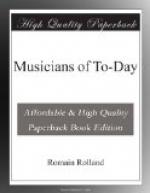Remark also Berlioz’s freedom of melody. His musical phrases pulse and flow like life itself. “Some phrases taken separately,” says Schumann, “have such an intensity that they will not bear harmonising—as in many ancient folk-songs—and often even an accompaniment spoils their fulness."[89] These melodies so correspond with the emotions, that they reproduce the least thrills of body and mind by their vigorous workings-up and delicate reliefs, by splendid barbarities of modulation and strong and glowing colour, by gentle gradations of light and shade or imperceptible ripples of thought, which flow over the body like a steady tide. It is an art of peculiar sensitiveness, more delicately expressive than that of Wagner; not satisfying itself with the modern tonality, but going back to old modes—a rebel, as M. Saint-Saens remarks, to the polyphony which had governed music since Bach’s day, and which is perhaps, after all, “a heresy destined to disappear."[90]
[Footnote 89: Ibid. “A rare peculiarity,” adds Schumann, “which distinguishes nearly all his melodies.” Schumann understands why Berlioz often gives as an accompaniment to his melodies a simple bass, or chords of the augmented and diminished fifth—ignoring the intermediate parts.]
[Footnote 90: “What will then remain of actual art? Perhaps Berlioz will be its sole representative. Not having studied the pianoforte, he had an instinctive aversion to counterpoint. He is in this respect the opposite of Wagner, who was the embodiment of counterpoint, and drew the utmost he could from its laws” (Saint-Saens).]
How much finer, to my idea, are Berlioz’s recitatives, with their long and winding rhythms,[91] than Wagner’s declamations, which—apart from the climax of a subject, where the air breaks into bold and vigorous phrases, whose influence elsewhere is often weak—limit themselves to the quasi-notation of spoken inflections, and jar noisily against the fine harmonies of the orchestra. Berlioz’s orchestration, too, is of a more delicate temper, and has a freer life than Wagner’s, flowing in an impetuous stream, and sweeping away everything in its course; it is also less united and solid, but more flexible; its nature is undulating and varied, and the thousand imperceptible impulses of the spirit and of action are reflected there. It is a marvel of spontaneity and caprice.
[Footnote 91: Jacques Passy notes that with Berlioz the most frequent phrases consist of twelve, sixteen, eighteen, or twenty bars. With Wagner, phrases of eight bars are rare, those of four more common, those of two still more so, while those of one bar are most frequent of all (Berlioz et Wagner, article published in Le Correspondant, 10 June, 1888).]
In spite of appearances, Wagner is a classicist compared with Berlioz; he carried on and perfected the work of the German classicists; he made no innovations; he is the pinnacle and the close of one evolution of art. Berlioz began a new art; and one finds in it all the daring and gracious ardour of youth. The iron laws that bound the art of Wagner are not to be found in Berlioz’s early works, which give one the illusion of perfect freedom.[92]




